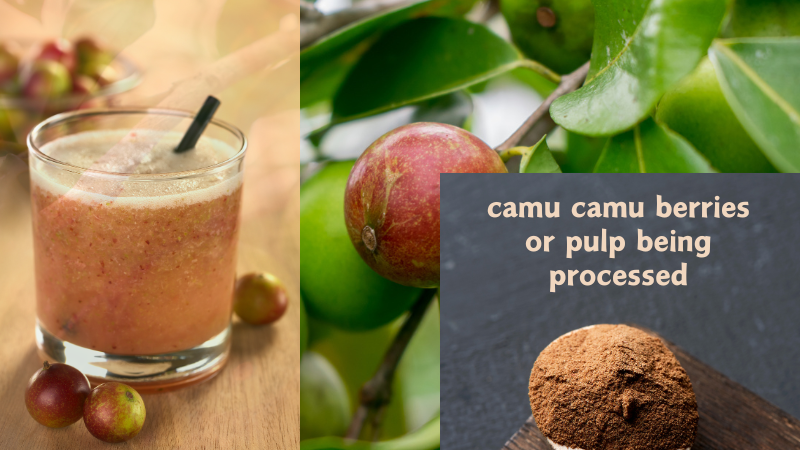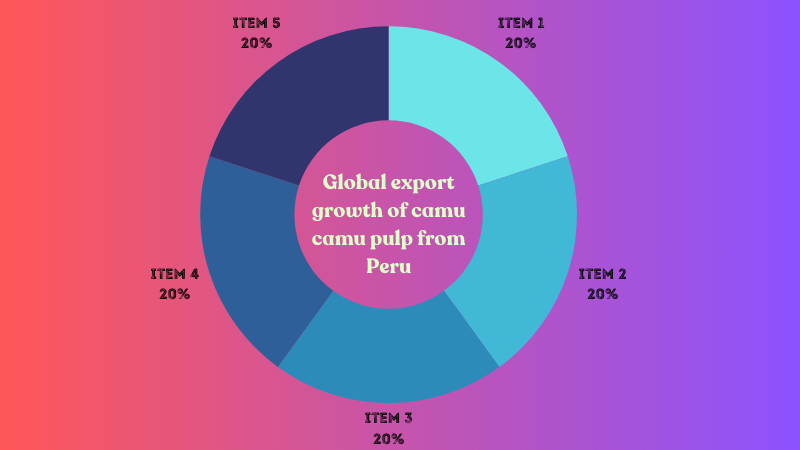Frozen Camu Camu Pulp: A Growing Global Market in 2025
Hey there! Have you ever heard of camu camu? This Amazon superfruit is causing a stir in global health. Its vitamin C content is extremely high. As more people learn of this berry, demand for camu camu products, like frozen pulp, is soaring. But did you know that Peru is leading the way in exporting this nutrient-rich fruit?
Introduction
Have you ever tasted camu camu? If you haven’t, you’re in for a treat—literally and figuratively. This Amazonian superfruit has caught the eye of health-conscious people worldwide. Its remarkable nutrition, especially the high vitamin C content, is a big reason why. Camu camu (scientific name Myrciaria dubia) is a small, sour berry native to the Amazon Rainforest, primarily found in Peru and Brazil.
One of the most popular forms of camu camu for global distribution is frozen pulp. Freezing keeps the berry’s nutrients, flavor, and bright color. This makes it great for superfood products like juices, smoothies, supplements, and cosmetics. The real question is: Why are Peruvian companies at the forefront of exporting this valuable fruit? What sets their frozen camu camu pulp apart?
This article explores the growing market for frozen camu camu pulp. We’ll highlight the Peruvian companies that are driving exports. We’ll look at the health benefits of camu camu. We’ll also discuss the challenges and opportunities for Peruvian exporters. Plus, we will examine the export process, market demand, and key players in this fast-growing industry.
This article will explore Peruvian firms exporting frozen camu camu pulp. We’ll look at the rising demand and what makes this product special. Ready to dive in? Let’s explore the story of Peru’s camu camu and the companies that are bringing it to the world stage.
What Is Camu Camu?
Camu camu is a small fruit that grows on a shrub native to the Amazon Rainforest. The plant thrives in the riverbanks of Peru, Brazil, Colombia, and other parts of the Amazon. The fruit itself is about the size of a grape, with a tangy, tart flavor that makes it unpalatable to eat raw in large quantities. The berry is valuable in the global health food market. It has a high level of vitamin C, antioxidants, and other nutrients.

Health Benefits of Camu Camu
Camu camu is packed with several health-promoting nutrients. Here are some key benefits of consuming camu camu:
- High Vitamin C Content: Camu camu contains 30 to 60 times more vitamin C than an orange. This high level of vitamin C is great for boosting immunity. It helps fight colds and protects skin from UV damage.
- Antioxidants: Besides vitamin C, camu camu has flavonoids, polyphenols, and other antioxidants. These compounds help neutralize harmful free radicals in the body. Antioxidants help reduce inflammation, boost skin health, and protect against chronic diseases.
- Anti-inflammatory Properties: Camu camu has been shown to reduce inflammation in the body. It may also improve the function of the immune system and reduce the risk of developing inflammatory diseases such as arthritis.
- Mood Boosting: Some studies suggest that camu camu may help improve mood and reduce stress due to its high antioxidant content.
Given these health benefits, it’s no surprise that camu camu is being touted as a “superfruit” in the health and wellness community.
Why Frozen Pulp?
Freezing camu camu pulp helps preserve its nutrients and keeps the fruit’s flavor intact. This is crucial when exporting the fruit for international markets. The pulp is usually extracted, cleaned, deseeded, and then frozen in bulk. Frozen pulp is handy for smoothies, energy bars, juices, dietary supplements, and cosmetics.
Peruvian Companies Leading the Export of Frozen Camu Camu Pulp
Peru has become one of the largest producers and exporters of camu camu. The Amazon basin has rich natural resources and excellent growing conditions. This makes it ideal for cultivating this superfruit. Peruvian companies lead in exporting frozen camu camu pulp worldwide. They meet the rising demand for healthy superfoods.
Here are some of the top Peruvian companies involved in the export of frozen camu camu pulp:
1. Amazona Superfoods
Amazona Superfoods exports frozen camu camu pulp. They focus mainly on Europe and North America. The company teams up with local Amazonian farmers. It gives them fair pay and supports sustainable harvesting practices. They emphasize the importance of organic certification to meet the growing demand for natural, chemical-free products.
The company’s products are known for their high quality and commitment to sustainability. Amazona Superfoods works with small farmers to give them fair trade prices. This helps both the environment and local communities.
2. Peruvian Nature
Peruvian Nature is another key player in the frozen camu camu pulp export industry. This company offers a variety of Peruvian superfoods, with camu camu being one of its flagship products. Peruvian Nature is particularly known for its strict quality control and adherence to international food safety standards.
In addition to frozen pulp, the company also exports camu camu in powder form. Customers in North America, Europe, and Asia can add camu camu to many health products. This includes smoothies and protein bars. Peruvian Nature cares about sustainability. It sources its camu camu from organic, certified farms that use ethical practices.
3. Candela Peru
Candela Peru has made a name for itself as a reliable exporter of organic products from the Amazon. Their frozen camu camu pulp is widely distributed in the U.S. and European markets, where it is used in a variety of health and wellness products.
Candela Peru is committed to supporting local farmers and promoting sustainable agricultural practices. The company sources its camu camu from small communities. This helps preserve biodiversity and boosts local economies.
4. EcoAndino
EcoAndino is another prominent Peruvian company known for its export of organic camu camu pulp. The company focuses on sustainability. It partners with small farming communities in the Amazon region. Their products are certified fair trade, ensuring that the farmers receive fair compensation for their work.
EcoAndino markets its products to health-conscious consumers, with a particular emphasis on the high-end organic food market. Their frozen camu camu pulp is in demand among consumers looking for premium, ethically sourced superfoods.
The Export Process of Frozen Camu Camu Pulp
The export process of frozen camu camu pulp has key stages. First, workers harvest the fruit in the Amazon. Then, they ship it to global markets.
1. Harvesting the Fruit
Camu camu is harvested by hand in the wild. Local Amazonian communities are key to the harvest. They have the knowledge and skills needed to find and collect the fruit. The harvesting process is sustainable, with farmers taking care not to over-harvest or damage the ecosystem.
2. Processing the Fruit
Once harvested, the camu camu berries are taken to processing plants where they are cleaned, deseeded, and turned into pulp. The pulp is then frozen immediately to preserve its freshness and nutrient profile. This process is key. It helps keep the pulp’s high vitamin C content safe during transport and storage.
3. Quality Control and Certification
Most Peruvian companies exporting camu camu pulp follow strict quality control procedures. The fruit is usually certified organic. It follows international food safety standards like HACCP (Hazard Analysis Critical Control Point). This ensures it meets global market requirements. Organic certification matters a lot to consumers in Europe and North America. They want products that are natural and free from pesticides.
4. Shipping and Distribution
Once the pulp is frozen, it gets packaged in bulk. Then, it is shipped to international markets in refrigerated containers. Cold chain logistics are key for keeping the quality and nutrition of camu camu pulp during shipping.
Global Demand for Frozen Camu Camu Pulp
Frozen camu camu pulp is in high demand now. North America, Europe, and Asia are the biggest buyers. Here’s a breakdown of demand by region:
North America
In the U.S. and Canada, frozen camu camu pulp is used primarily in smoothies, juices, and dietary supplements. Health-conscious consumers like the product for its immune-boosting benefits. This is especially attractive during cold and flu season.
Europe
European consumers are increasingly focused on organic, fair-trade products. Peruvian exporters meet this need with organic, sustainably harvested camu camu pulp. Countries like Germany, the UK, and the Netherlands are major importers of camu camu pulp, where it is often used in health food products and juices.
Asia
The Asian market is growing fast. Japan and South Korea are leading this trend. There, the demand for superfoods is rising sharply. Camu camu is being marketed as a natural, immune-boosting supplement, with a focus on its high vitamin C content.

Challenges Facing Peruvian Exporters
The demand for frozen camu camu pulp is rising. However, Peruvian companies face several challenges:
1. Logistics and Cold Chain Management
Maintaining a frozen supply chain can be difficult, especially when shipping to distant markets. Companies need to invest in good refrigeration and shipping systems. This way, the pulp stays fresh and full of nutrients.
2. Market Competition
Brazil is a big producer of camu camu. So, Peruvian exporters need to keep innovating and making their products unique. Focus on quality, sustainability, and strong brand recognition in global markets.
3. Sustainability Concerns
As the demand for camu camu grows, there is an increasing risk of over-harvesting and environmental damage. Exporters must work with local communities. This helps ensure sustainable harvesting. It protects the delicate Amazon ecosystem.
Opportunities for Growth in 2024 and Beyond
The global superfood market will grow more in 2024. Peruvian companies have a big chance to grow. New processing technologies and better cold chain logistics can cut costs and boost efficiency.
As consumers learn about the health benefits of camu camu, companies can offer more products. They can add camu camu supplements, powders, and beauty items to their range. Peruvian companies can thrive in the global market by meeting the rising demand for organic and sustainable products.
FAQs About Peruvian Companies Exporting Frozen Camu Camu Pulp
Camu camu pulp is high in vitamin C and antioxidants. So, it is in demand in the health food industry. Freezing the pulp preserves its nutritional value for export.
The United States, Europe, and parts of Asia are the largest markets for frozen camu camu pulp.
Yes! Many Peruvian exporters work with local communities. They use sustainable harvesting to protect the Amazon.
You can find frozen camu camu pulp from online retailers or speciality health food stores. Many companies also offer bulk options for businesses.
Most Peruvian exporters sell organic, certified camu camu. It is free from pesticides and harmful chemicals.
Conclusion
Peruvian companies that export frozen camu camu pulp lead the growing global superfood market. They focus on sustainability, organic certification, and quality control. This helps them meet the growing demand for this nutrient-rich fruit in North America, Europe, and Asia. With the rising demand for camu camu, these companies are set for success. They offer a strong natural product that helps health and well-being to consumers around the globe.
Next time you enjoy a smoothie or take a supplement, remember the Peruvian companies that make the frozen camu camu pulp for your superfoods!






